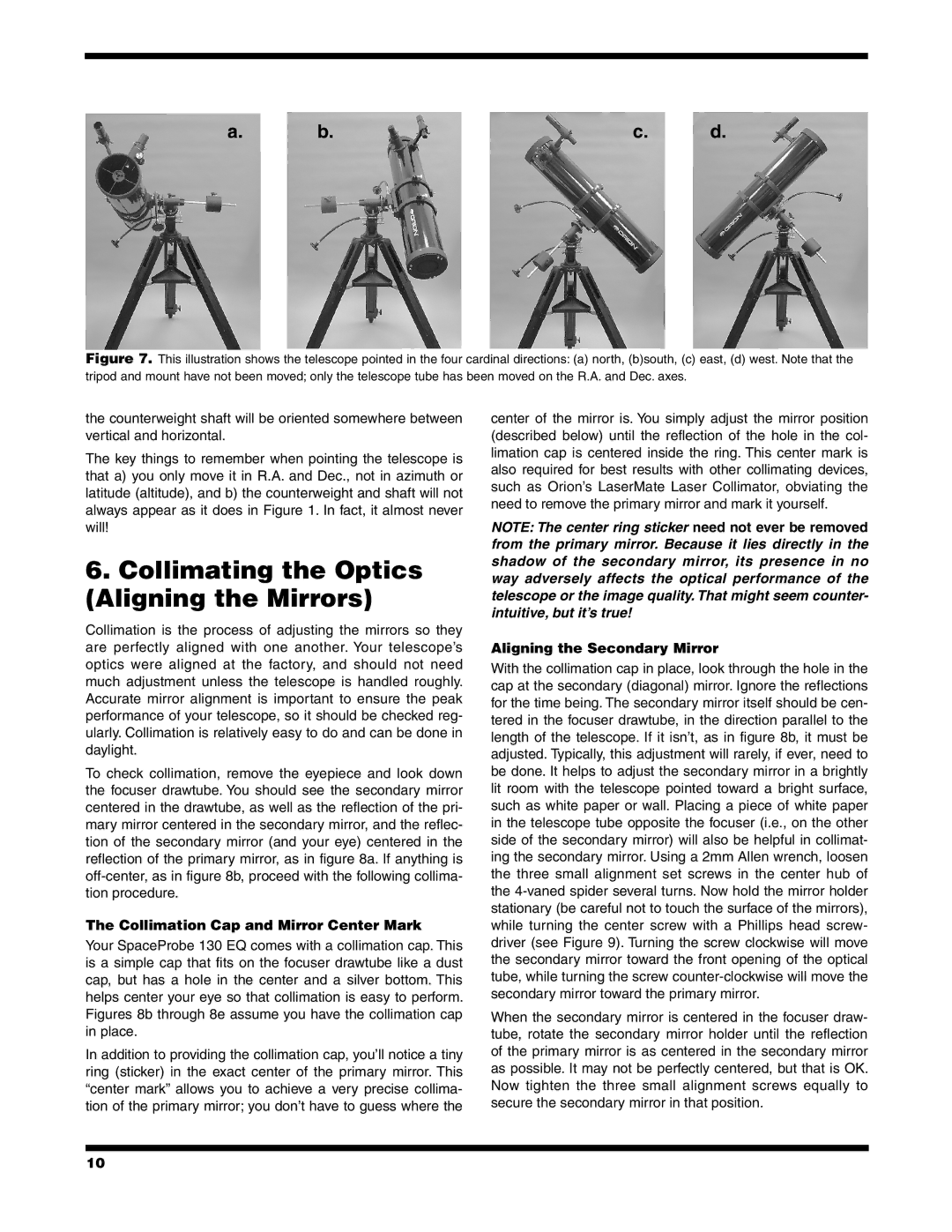
a. | b. | c. | d. |
Figure 7. This illustration shows the telescope pointed in the four cardinal directions: (a) north, (b)south, (c) east, (d) west. Note that the tripod and mount have not been moved; only the telescope tube has been moved on the R.A. and Dec. axes.
the counterweight shaft will be oriented somewhere between vertical and horizontal.
The key things to remember when pointing the telescope is that a) you only move it in R.A. and Dec., not in azimuth or latitude (altitude), and b) the counterweight and shaft will not always appear as it does in Figure 1. In fact, it almost never will!
6.Collimating the Optics (Aligning the Mirrors)
Collimation is the process of adjusting the mirrors so they are perfectly aligned with one another. Your telescope’s optics were aligned at the factory, and should not need much adjustment unless the telescope is handled roughly. Accurate mirror alignment is important to ensure the peak performance of your telescope, so it should be checked reg- ularly. Collimation is relatively easy to do and can be done in daylight.
To check collimation, remove the eyepiece and look down the focuser drawtube. You should see the secondary mirror centered in the drawtube, as well as the reflection of the pri- mary mirror centered in the secondary mirror, and the reflec- tion of the secondary mirror (and your eye) centered in the reflection of the primary mirror, as in figure 8a. If anything is
The Collimation Cap and Mirror Center Mark
Your SpaceProbe 130 EQ comes with a collimation cap. This is a simple cap that fits on the focuser drawtube like a dust cap, but has a hole in the center and a silver bottom. This helps center your eye so that collimation is easy to perform. Figures 8b through 8e assume you have the collimation cap in place.
In addition to providing the collimation cap, you’ll notice a tiny ring (sticker) in the exact center of the primary mirror. This “center mark” allows you to achieve a very precise collima- tion of the primary mirror; you don’t have to guess where the
center of the mirror is. You simply adjust the mirror position (described below) until the reflection of the hole in the col- limation cap is centered inside the ring. This center mark is also required for best results with other collimating devices, such as Orion’s LaserMate Laser Collimator, obviating the need to remove the primary mirror and mark it yourself.
NOTE: The center ring sticker need not ever be removed from the primary mirror. Because it lies directly in the shadow of the secondary mirror, its presence in no way adversely affects the optical performance of the telescope or the image quality. That might seem counter intuitive, but it’s true!
Aligning the Secondary Mirror
With the collimation cap in place, look through the hole in the cap at the secondary (diagonal) mirror. Ignore the reflections for the time being. The secondary mirror itself should be cen- tered in the focuser drawtube, in the direction parallel to the length of the telescope. If it isn’t, as in figure 8b, it must be adjusted. Typically, this adjustment will rarely, if ever, need to be done. It helps to adjust the secondary mirror in a brightly lit room with the telescope pointed toward a bright surface, such as white paper or wall. Placing a piece of white paper in the telescope tube opposite the focuser (i.e., on the other side of the secondary mirror) will also be helpful in collimat- ing the secondary mirror. Using a 2mm Allen wrench, loosen the three small alignment set screws in the center hub of the
When the secondary mirror is centered in the focuser draw- tube, rotate the secondary mirror holder until the reflection of the primary mirror is as centered in the secondary mirror as possible. It may not be perfectly centered, but that is OK. Now tighten the three small alignment screws equally to secure the secondary mirror in that position.
10
